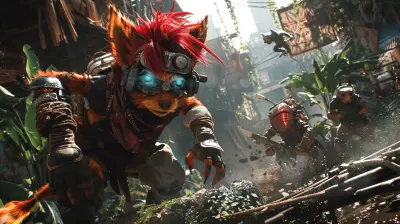The Evolution of Game Libraries in the Cloud
7 September 2025
Let’s face it — the way we play games has taken a wild turn over the past couple of decades. Gone are the days when we’d stack game cartridges on shelves or swap scratched-up disks with friends. Today, gaming is flying high — literally. We’re streaming, downloading, and launching titles straight from the cloud. Welcome to the era of cloud-based game libraries, where the only thing standing between you and your favorite title is a decent internet connection.
So how exactly did we go from blowing into cartridges to booting up games from thin air? Buckle up, because we’re going on a pixel-packed ride through the mind-blowing evolution of game libraries in the cloud.
The Humble Beginnings: Physical Media Madness
Remember the good ol’ days of carrying around a backpack full of game disks like you were prepping for some kind of apocalyptic LAN party? Yeah, we’ve been there.Cartridge Days: Insert and Pray
The earliest days of gaming were all about physical media. Cartridges ruled the world — Nintendo, Sega, and Atari had us clicking cartridges into chunky consoles like our lives depended on it.But here’s the thing — game libraries were completely physical. If you wanted more games, you needed more shelf space. And God forbid you lost a cartridge or scratched a disk — rip to your weekend.
CDs, DVDs, and the Rise of Collections
Fast forward a few years, and we upgraded to CDs and DVDs. The graphics got better, the games got longer, and our collections got insanely big. Entire rooms turned into shrines of jewel cases and collector’s editions. Cool? Sure. Convenient? Not even close.
Enter the Digital Revolution: Game Libraries Go Virtual
Welcome to the early 2000s. Internet speeds were crawling, but platforms like Steam decided to dream big — sell games online, store them in your account, and let you download them whenever. Revolutionary!Steam: The Digital Pioneer
Valve’s Steam practically invented the digital library model for PC gamers. Suddenly, no more lost disks, no more waiting in lines at GameStop. Just a click, a download bar, and boom — you're playing.Steam’s success inspired others too. Xbox Live, PlayStation Network, and platforms like Origin, Epic Games Store, and GOG followed suit. Everyone wanted in on this new digital era.
Pros and Cons of Going Digital
On the plus side? Your entire library, in one place, accessible anywhere. On the downside? Still dependent on local hardware. Run out of storage? Time to delete something. Want to play on another device? Good luck without a monster rig.
The Cloud Enters the Chat
Then came the cloud. Nope, not the fluffy kind — the tech kind that quietly transformed everything from photo storage to binge-watching shows. Now it’s gaming’s turn.What Even Is Cloud Gaming?
Let’s keep it simple. Cloud gaming means the game isn’t actually running on your device. It’s running on some crazy-powerful server somewhere, and you’re just streaming the gameplay — like Netflix, but interactive.You press a button, the command goes to the server, it processes it, and sends you back the next frame of gameplay. All of this happens in milliseconds. It sounds like magic, but it’s just clever bandwidth, powerhouse servers, and some serious networking wizardry.
Why Gamers Are Hyped (And Cautiously Optimistic)
Cloud-based game libraries mean no downloads, no updates, no storage issues. You just launch a game from your library and go. Want to play on your phone, tablet, laptop, or smart TV? Done. Your library follows you — anytime, anywhere.But let’s not pretend it’s perfect. Lag, latency, and data caps can still rain on your parade. Still, the sheer convenience? Pretty hard to ignore.
The Big Players in the Cloud Library Game
Several tech and gaming giants are leading the charge in cloud-based libraries. Let’s break it down.Xbox Game Pass Ultimate + Cloud Gaming (xCloud)
Microsoft didn’t just dip a toe in the cloud — they cannonballed in. With Game Pass Ultimate, players get access to a monster-sized library of games they can download or stream via xCloud.Think of it as Netflix meets a gaming buffet. You don’t own the games, but you get access to a rotating feast of titles. It’s convenient, cost-effective, and dangerously addictive.
NVIDIA GeForce NOW
This one's for the PC purists. Instead of giving you a set library, GeForce NOW lets you link your existing Steam, Epic, and other accounts — and stream the games you already own.You’re basically renting a high-end gaming PC that lives in the cloud. Fire up your device, and suddenly your potato laptop becomes a 4K gaming beast.
PlayStation Plus + Cloud Streaming
Sony’s rebranded PlayStation Plus now includes cloud game streaming for certain titles, mostly catering to classics and back-catalog gems. It’s a work in progress, but it’s a solid step toward a full-blown cloud library.Google Stadia (RIP) & Amazon Luna
Okay, real talk — Stadia had potential but fizzled hard. Still, it proved a point: cloud gaming is a beast, but launching a platform from scratch is no joke. Amazon’s Luna is still trying, offering a channel-based subscription model, though it’s not exactly dominating the market.How Cloud Libraries Are Changing How We Play
Let’s go beyond the tech specs and talk real impact. Cloud game libraries are flipping gaming culture on its head.Accessibility Like Never Before
No console? No high-end PC? No problem. With cloud gaming, your phone can handle AAA games. That’s opening doors for millions of new gamers who don’t have the budget or space for expensive hardware.Suddenly, the world of gaming is no longer locked behind a paywall of pricey consoles and gaming rigs. All you need is a screen and internet.
Say Goodbye to the Infinite Backlog (Sort Of)
We’ve all got that digital guilt — the backlog of games we bought during sales and never actually played. With cloud gaming libraries, trialing a game becomes painless. No download, no commitment. Click and try. If it sucks? Move on.Game Ownership Gets... Weird
Here's the kicker — in the cloud, you don’t really “own” your games. You rent access. If a game leaves the catalog or if the service shuts down (RIP Stadia), poof — it’s gone.This shift from ownership to access is a big deal. It’s Netflix-ifying gaming. Some love the convenience. Others miss the good ol’ days of owning something tangible.
The Tech Driving the Cloud Revolution
Cloud gaming isn’t just pressing play on a title. There’s a symphony of tech happening behind the scenes.Data Centers and GPUs on Steroids
Every time you play from the cloud, you’re connecting to a data center filled with powerhouse gaming PCs. These machines are rocking GPUs that most of us can only dream of affording.Edge Computing: Reducing Lag Like a Ninja
Edge computing brings servers closer to you, so your data doesn’t have to travel across continents just to shoot a zombie. It reduces latency and makes cloud gaming actually playable — even competitive.5G and Future-Proofing
5G is the gasoline throwing fire on the cloud gaming engine. With speeds and latency that rival home networks, mobile cloud gaming is becoming legit. The future? You’re playing full-quality games on your lunch break, no console required.What’s Next for Cloud-Based Game Libraries?
We’re just scratching the surface here. The next few years? Buckle up.AI + Cloud Gaming = Dynamic Experiences
AI-driven tools are already being used to optimize game streaming quality in real-time. Future cloud libraries might tailor experiences to your hardware, preferences, even your mood.Hybrid Models: Own, Subscribe, or Stream
Gaming platforms are experimenting with hybrid models — own a game digitally, stream it when you’re on the go, download it when you’re at home. Ultimate flexibility.Cross-Platform Heaven
Cloud libraries are breaking down platform walls. Play a game on your console, pick up where you left off on your phone — all synced via the cloud. It’s the dream, and it’s getting real.The Big Question: Is Cloud the Endgame?
So, is the future of gaming entirely cloud-based? Maybe. Maybe not.A lot of folks still love owning games. Collectors want physical editions. Modders want access to game files. Competitive players want zero-lag environments. There’s room for all of it — cloud will coexist, not necessarily replace.
But one thing is for sure — if you’re a gamer today, your library lives in the cloud, whether you like it or not. Game saves, achievements, online play, even some titles — all tied to servers living in invisible warehouses.
We're already there. And it's only going to grow.
Final Thoughts
The evolution of game libraries in the cloud isn’t just about technology — it’s about how we relate to games, how we access them, and how they’re becoming more democratic than ever.We’ve gone from blowing into cartridges to streaming 4K monsters on a phone in the span of a couple of decades. That’s not just progress. That’s a revolution.
So the next time you're logging into your gaming library from a device that fits in your pocket, just remember: we’re living in the future, and it’s freaking awesome.
all images in this post were generated using AI tools
Category:
Cloud GamingAuthor:

Whitman Adams
Discussion
rate this article
1 comments
Octavia Fletcher
Great insights! The evolution of cloud game libraries truly transforms how we play and connect.
September 8, 2025 at 2:55 AM

Whitman Adams
Thank you! I'm glad you found the insights valuable. The shift to cloud game libraries indeed reshapes our gaming experiences and connections.


